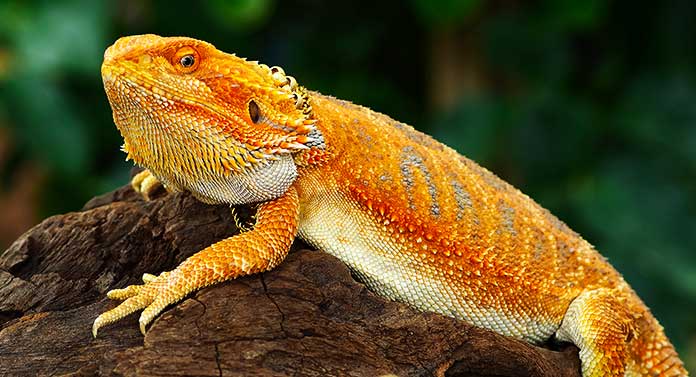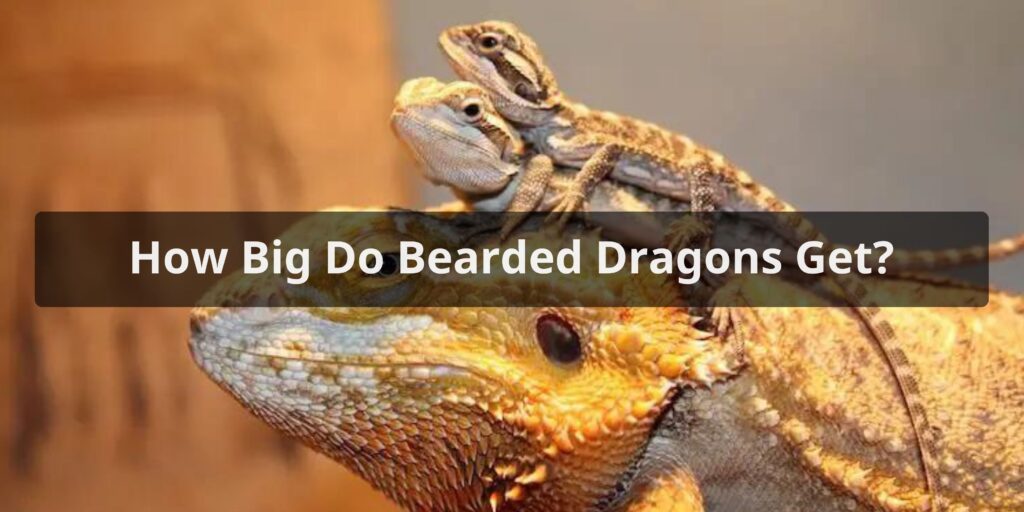Bearded dragons are a popular pet lizard known for their docile nature, hardy constitution, and unique appearance. Their name derives from the ‘beard’ of spiny scales that flares out from under their chin when threatened. As bearded dragons grow and mature, going through several distinct stages, their size increases dramatically from tiny hatchlings to chunky adults. So how big does a bearded dragon get?
Typical Adult Size

On average, most bearded dragons will reach an adult size of 18-24 inches (45-60 cm) in length from the tip of the nose to the end of the tail. Their weight usually ranges between 350-550 grams when fully grown.
Males tend to remain on the smaller end of this range, averaging about 18-22 inches long and 400-500 grams in weight. Females grow larger than males in most cases, averaging 20-24 inches in length and 450-600 grams in weight. The largest recorded specimen was a female that measured 28 inches long.
So while there is some variation in size depending on sex, genetics, and care – most adult bearded dragons land solidly in the 18-24 inch and 350-600 gram range. This makes them a medium-sized lizard species when compared to other common pet reptiles.
Growth Rate and Stages
Bearded dragons grow rapidly for the first 12-18 months of life before their growth rate slows down. The growth stages include:
Hatchlings
Newly hatched bearded dragons are tiny – measuring just 3-5 inches long and weighing 5-10 grams. But they grow quickly, reaching 9-12 inches in the first 2-3 months. Proper feeding and care is crucial at this delicate baby stage.
Juveniles
Between 3-8 months of age, beardies are considered juveniles. This is a period of rapid growth as they reach 12-18 inches long. Their adult coloration starts to come in and they become more active and adept at hunting insects.
Subadults
From 8-18 months old, beardies reach subadult status. Their length averages 16-20 inches as growth begins slowing down. They fill out more and need larger enclosures during this teenage stage.
Adults
After 18 months, bearded dragons are considered full adults. They reach their maximum size of 18-24 inches and 350-600 grams at this point. Adults have prominent head scales, are sexually mature, and have more sedentary temperaments.
Factors Affecting Adult Size
While genetics play a key role, several factors also influence a bearded dragon’s ultimate adult size:
- Sex – As mentioned above, females typically grow larger than males. This is likely due to reproductive demands.
- Diet – Proper nutrition supports healthy growth. Feed babies and juveniles frequently with protein-rich insects and chopped vegetables.
- Health – Underlying health issues may stunt growth. Yearly vet checkups help monitor for problems.
- Husbandry – Appropriate housing, temperature gradients, UV lighting and more create the ideal environment for growth.
- Lineage – Some bloodlines naturally produce larger or smaller bearded dragons on average.
With attentive care given to all these factors, most bearded dragons reach their maximum genetic potential size-wise.
Is Bigger Always Better?
While large bearded dragons may seem impressive, bigger is not necessarily better when it comes to pet reptile health. Obese or oversized beardies can actually face issues like:
- Increased difficulty finding comfortable basking spots
- Pressure sores and abrasions from contact with enclosure furnishings
- Challenges fitting inside hides and other cage decor
- Reduced mobility and activity levels
- Shortened lifespan and premature aging
Therefore, a moderate healthy adult size is ideal for bearded dragons to thrive. Focus on balanced diets, proper husbandry, and genetics over just sheer bulk or length when selecting and raising pet beardies.
Conclusion
To recap, most bearded dragons grow to an adult length of 18-24 inches and weigh between 350-550 grams once fully mature after 12-18 months of age. Careful attention to the lizard’s diet, health, housing, lineage, and other factors during their rapid baby and juvenile growth stages helps ensure they reach a healthy adult size. While giant beardies may seem neat, moderation is best when it comes to their ultimate size. Proper husbandry and genetics, not overfeeding, are the keys producing a long-lived, moderate-sized adult bearded dragon.
FAQs About How Big Does a Bearded Dragon Get
What factors can influence the growth and size of a bearded dragon?
Several factors impact a bearded dragon’s growth, including genetics, diet, temperature, and habitat conditions. Providing a balanced diet, proper lighting, and maintaining ideal temperature ranges are crucial for healthy growth.
Are there any indicators of a healthy growth rate in bearded dragons?
A healthy growth rate is characterized by steady, proportional growth without signs of malnourishment or obesity. Monitor your dragon’s weight and length to ensure they are reaching appropriate milestones for their age.
Can I control the size of my bearded dragon through diet and habitat conditions?
While you can influence their growth, you cannot significantly alter their genetics. Proper diet, consistent UVB lighting, and maintaining appropriate temperatures and habitat conditions are essential for their well-being and growth.
What are the smallest and largest recorded sizes for bearded dragons?
The smallest recorded bearded dragons are often premature hatchlings, measuring around 3 inches. The largest recorded individuals have exceeded 24 inches in length, although such extreme sizes are rare.
What should I do if my bearded dragon is not growing as expected?
Consult a reptile veterinarian if your bearded dragon’s growth is stunted or inconsistent. They can assess potential health issues, recommend dietary adjustments, and provide guidance on improving growth conditions.
How does the size of a bearded dragon impact its care requirements and enclosure setup?
The size of your bearded dragon affects enclosure size, heating requirements, and diet portions. Larger dragons need more space, higher wattage heat lamps, and slightly larger meal portions compared to smaller individuals to ensure their comfort and well-being.



